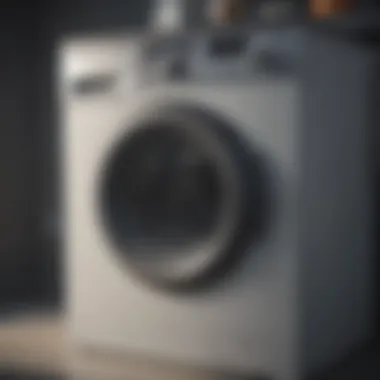Expert Guide: Mastering the Art of Cleaning Your Top Load Washer


The concept of cleaning a top load washer proficiently is vital for its optimal performance and longevity. With constant use, washers accumulate dirt and grime, affecting their efficiency. This article delves deep into the meticulous steps, techniques, and tips required to maintain your top load washer in top-notch condition.
Key Points
- Understanding the importance of regular washer maintenance
- Step-by-step guide on cleaning the exterior and interior components
- Tips on removing mold and mildew effectively
- Techniques to tackle detergent residue buildup
- Recommendations for using natural cleaning agents for a chemical-free wash experience.
Introduction
As we strive for efficiently performing household appliances, the maintenance of a top load washer often goes overlooked. Proper cleaning not only improves cleanliness but also ensures the durability of the washer. By incorporating specific steps and techniques, you can elevate the performance and longevity of your top load washer significantly.
Importance of Regular Maintenance
Regular maintenance is crucial for the proper functioning of any appliance. With a top load washer, neglecting maintenance can lead to mold growth, unpleasant smell, and reduced cleaning efficiency. By incorporating periodic cleaning routines, you can prevent these issues and uphold the overall performance of your washer.
Step-by-step Cleaning Guide
- Exterior cleaning: Start by wiping down the exterior with a damp cloth and mild detergent to remove dust and stains. Pay attention to control panels and knobs.
- Interior cleaning: Run a cleaning cycle with hot water, vinegar, and baking soda to eliminate bacteria and residue. Wipe the interior with a sponge for a thorough cleanse.
- Detergent drawer cleaning: Remove the detergent drawer and soak it in a vinegar solution. Scrub off any residue before reinstalling.
- Filter cleaning: Locate and clean the filter, removing any lint or debris that may affect drainage or cleaning efficiency.
- Door seal maintenance: Wipe the door seal with a mixture of water and bleach to prevent mold growth and maintain a fresh smell.
By following these detailed cleaning steps, you can ensure that your top load washer operates at its best capacity, providing you with clean laundry every time you use it.
Conclusion
Ensuring the cleanliness of your top load washer through regular and thorough cleaning practices is essential for preserving its performance and increasing its lifespan. By implementing the tips and techniques outlined in this expert guide, you can enjoy efficient washing results and a maintained appliance for years to come.
Understanding Your Top Load Washer
In the realm of laundry appliances, understanding the intricacies of your top load washer holds paramount importance. This article delves deep into the core components and functions of these washers, shedding light on key aspects that influence their performance and longevity. By comprehending the inner workings of your top load washer, you empower yourself to ensure its optimal operation and maintain its efficiency over time.
Identifying Key Components
The Agitator


The agitator, a central component of the top load washer, plays a pivotal role in the washing process. This cylindrical mechanism rotates back and forth, facilitating the movement of clothes in the water to dislodge dirt and grime effectively. Its robust design and agitating motion make it an ideal choice for thorough cleaning, especially when dealing with heavily soiled laundry loads. Despite its efficacy, the agitator's vigorous agitation may cause wear and tear on delicate fabrics, necessitating caution when washing more delicate items.
The Drum
The drum, another essential element of the top load washer, serves as the container where clothes are placed for washing. Its spacious design accommodates varying load sizes, allowing for efficient cleaning of different quantities of laundry. The smooth rotation of the drum ensures thorough washing and rinsing, resulting in impeccably clean garments. While the drum's large capacity enhances washing efficiency, it may consume more water and energy compared to compact washers, necessitating mindful usage to optimize resource consumption.
The Detergent Dispenser
The detergent dispenser in a top load washer is a convenient feature that simplifies the process of adding detergent to the laundry cycle. Typically located on the top panel of the washer, this compartment dispenses the detergent at the appropriate time during the wash cycle, ensuring proper distribution for effective cleaning. The dispenser's user-friendly design eliminates the need for manual detergent measurement, promoting convenience and accuracy in detergent usage. However, residue buildup in the dispenser may compromise washing performance, emphasizing the importance of regular cleaning to maintain optimal functionality.
Common Issues with Top Load Washers
Residue Buildup
Residue buildup in a top load washer poses a common yet concerning issue that impacts washing efficiency. Over time, detergent and fabric softener residues accumulate in various washer components, including the drum and agitator, leading to reduced cleaning performance and potential foul odors. To mitigate residue buildup, regular cleaning and maintenance practices are crucial to preserve the washer's effectiveness and prevent malodorous laundry outcomes.
Unpleasant Odors
Unpleasant odors emanating from a top load washer often stem from mildew growth within the drum or detergent dispenser. The damp environment of the washer contributes to mold and mildew proliferation, resulting in musty odors that transfer onto freshly washed clothes. Addressing unpleasant odors requires diligent cleaning of the washer's interior and dispensing compartments to eradicate mold spores and prevent future microbial growth, ensuring your laundry emerges fresh and odor-free.
Lint Accumulation
Lint accumulation is a prevalent issue in top load washers, attributed to fabric fibers shedding during the washing process. The presence of lint on freshly washed clothes diminishes their visual appeal and necessitates additional cleaning steps to remove embedded lint particles effectively. To combat lint accumulation, incorporating mesh lint traps in the washer and adhering to proper laundry sorting practices can minimize fiber shedding and enhance the cleanliness of laundered garments for a pristine appearance.
Cleaning Process
In this article, the Cleaning Process is an essential task that plays a significant role in maintaining the top load washer's functionality and longevity. By following a systematic cleaning routine, you can ensure that your washer operates efficiently and remains in optimal condition. Proper cleaning not only enhances the appliance's visual appeal but also prevents the development of mold, mildew, and odors.
Preparation
Gathering necessary supplies
Gathering necessary supplies is a crucial first step in the cleaning process. Having the right tools such as cleaning cloths, mild detergents, vinegar, and a scrubbing brush ensures a thorough and effective cleaning session. The choice of supplies should be based on their effectiveness in removing dirt and grime while being gentle on the washer's surfaces. Opting for high-quality cleaning products guarantees a safe and successful cleaning experience.


Safety precautions
Safety precautions are paramount during the cleaning process to prevent accidents and damage to the washer. Simple steps like unplugging the appliance before cleaning, wearing protective gloves, and ensuring proper ventilation in the area can significantly reduce the risk of mishaps. Following safety guidelines ensures the well-being of both the individual cleaning the washer and the appliance itself.
Cleaning the Exterior
Surface cleaning
Surface cleaning involves wiping down the exterior of the washer to remove dust, stains, and spills. Using a mild detergent and a soft cloth, you can gently clean the surfaces without causing any damage. Regular surface cleaning not only keeps the washer looking new but also prevents dirt buildup, maintaining its overall hygiene and appearance.
Control panel care
Taking care of the control panel is crucial to prevent any malfunctions or disruptions in the washer's operation. Using a damp cloth, carefully clean the control panel while avoiding excess moisture that could seep into the controls. Proper control panel care ensures that the washer's settings remain intact and functional for smooth operation.
Cleaning the Interior
Drum cleaning methods
Utilizing effective drum cleaning methods such as running a cleaning cycle with vinegar or bleach helps remove soap scum, bacteria, and residue from the drum. Regular drum cleaning prevents unpleasant odors and ensures that your clothes come out clean and fresh after every wash cycle.
Agitator maintenance
Maintaining the agitator involves inspecting for any trapped debris or buildup that could affect its performance. Using a gentle cleaning solution and a soft brush, you can clean the agitator to ensure it rotates smoothly during wash cycles. Proper agitator maintenance prolongs its lifespan and enhances the washer's overall cleaning efficiency.
Addressing Stubborn Stains and Odors
Dealing with mold and mildew
To address mold and mildew issues, consider using natural remedies like vinegar or commercial mold cleaners. Thoroughly cleaning affected areas and allowing proper ventilation can help eliminate mold spores and prevent regrowth. Tackling mold and mildew promptly ensures a hygienic washing environment and prolongs the washer's durability.
Freshening up the washer


Freshening up the washer involves adding baking soda or specialized washer cleaners to remove stubborn odors and residues. Running a hot water cycle with these additives helps disinfect the washer and leaves it smelling fresh. Regularly freshening up the washer maintains a pleasant laundry experience and extends the appliance's lifespan.
Maintenance Tips
Maintaining your top load washer is crucial to ensure its longevity and optimal performance. By following a regular maintenance schedule, you can prevent potential issues and keep your washer running smoothly for years to come. Neglecting maintenance may lead to problems such as residue buildup, unpleasant odors, and malfunctioning components, which can be costly to repair. Therefore, incorporating maintenance tips into your routine is essential for the overall efficiency of your washing machine.
When it comes to a regular cleaning schedule, it is recommended to clean your washer at least once a month to prevent dirt and detergent residue from accumulating inside the drum and other components. This frequency ensures that your washer remains odor-free and maintains its cleaning efficiency. Consistent cleaning also helps in preventing mold and mildew growth, which can be challenging to remove once developed. By adhering to a monthly cleaning routine, you are proactively preserving the quality and lifespan of your top load washer.
Embracing best practices for maintaining your washer involves using high-quality detergents that are suitable for top load washers. Choosing detergents specifically designed for your machine helps in preventing residue buildup and maintains the washer's functionality. Opting for renowned detergent brands with favorable reviews ensures that your washer stays clean and efficient with each wash cycle. Additionally, utilizing the recommended amount of detergent per load prevents oversudsing and residue formation, contributing to the overall cleanliness of your washer.
Incorporating preventive measures such as proper ventilation is instrumental in maintaining the health of your top load washer. Adequate airflow around the machine prevents moisture accumulation, reducing the chances of mold or mildew growth. Ensure that the area where the washer is placed is well-ventilated to promote proper drying after each use. Utilizing fans or opening windows nearby can facilitate air circulation and aid in preventing unwanted odors or bacterial growth inside the washer. By implementing ventilation tips, you enhance the operational efficiency of your top load washer and safeguard it against potential issues.
Troubleshooting
When it comes to maintaining your top load washer, troubleshooting plays a pivotal role in identifying and rectifying common issues that may hinder its optimal performance. Understanding the troubleshooting process can help you address problems promptly, ensuring that your washer continues to function effectively for years to come. By troubleshooting, you can diagnose issues such as water drainage problems, cycle irregularities, and unusual noises, enabling you to take the necessary steps to resolve them efficiently.
Common Problems and Solutions
Water Drainage Issues
Water drainage issues are a common concern that can impede the functionality of your washer. These problems often arise due to clogged drains, improper installation, or blockages in the drainage system. Proper maintenance and regular inspection can help prevent water drainage issues, ensuring smooth operation. By addressing these issues promptly, you can avoid potential water damage and extend the lifespan of your appliance.
Cycle Irregularities
Cycle irregularities can disrupt the normal operation of your washer, leading to inefficient cleaning and rinse cycles. Issues such as imbalanced loads, malfunctioning sensors, or electrical problems can cause cycle irregularities. Understanding the root cause of these issues and implementing appropriate solutions is crucial for restoring your washer's performance. Regularly checking for load balance, cleaning sensors, and inspecting electrical connections can help mitigate cycle irregularities, ensuring consistent results with each wash.
Unusual Noises
Unusual noises emitted during the washer's operation can be a sign of underlying issues that require attention. These noises can result from worn-out bearings, loose components, or imbalanced loads. Ignoring unusual noises can lead to further damage and affect the washer's overall performance. By identifying and addressing the source of these sounds, you can prevent potential breakdowns and maintain the integrity of your washer. Regularly inspecting and servicing the internal components can help reduce or eliminate unusual noises, ensuring smooth and quiet operation.
Final Thoughts
In the final segment of this expert guide on cleaning your top load washer, we delve into crucial aspects that are pivotal for maintaining the longevity and optimal performance of your appliance. It is essential to comprehend the significance of regular maintenance to ensure that your washer operates efficiently for an extended period. By adopting beneficial habits and implementing proper care routines, you can significantly enhance the lifespan and functionality of your washer. This section aims to emphasize the critical role of maintenance practices and habits in preserving the performance and durability of your top load washer.## Ensuring Longevity and Performance
The Importance of Maintenance
Within the realm of enhancing the longevity and performance of your washer, the importance of maintenance emerges as a fundamental element. Regular upkeep not only increases the operational efficiency of the appliance but also reduces the likelihood of potential breakdowns and costly repairs. By adhering to a structured maintenance schedule, you can prevent premature wear and tear, ensuring that your washer functions optimally. The consistency of maintenance activities such as cleaning the drum, maintaining the agitator, and inspecting for any irregularities contributes significantly to the overall well-being of your washer. This meticulous attention to detail in maintenance is essential for maximizing the lifespan of your appliance and safeguarding its operational capabilities. Embracing the significance of maintenance fosters a proactive approach towards preserving the longevity and performance of your top load washer.### Beneficial Habits
In addition to maintaining the appliance, cultivating beneficial habits plays a pivotal role in ensuring the enduring performance of your top load washer. Simple practices such as using appropriate detergents, following recommended loading guidelines, and allowing proper ventilation can significantly impact the efficiency and longevity of your washer. Consistent adherence to these beneficial habits minimizes the accumulation of residue, reduces the chances of mold and mildew formation, and eliminates potential issues that may arise due to neglect. By integrating these habits into your regular washing routine, you create a conducive environment for your appliance to function optimally. Furthermore, adopting beneficial habits not only enhances the performance of your washer but also contributes to a more sustainable and cost-effective laundry experience. These habits, when maintained diligently, ensure that your top load washer continues to operate efficiently and reliably, prolonging its lifespan and performance.



